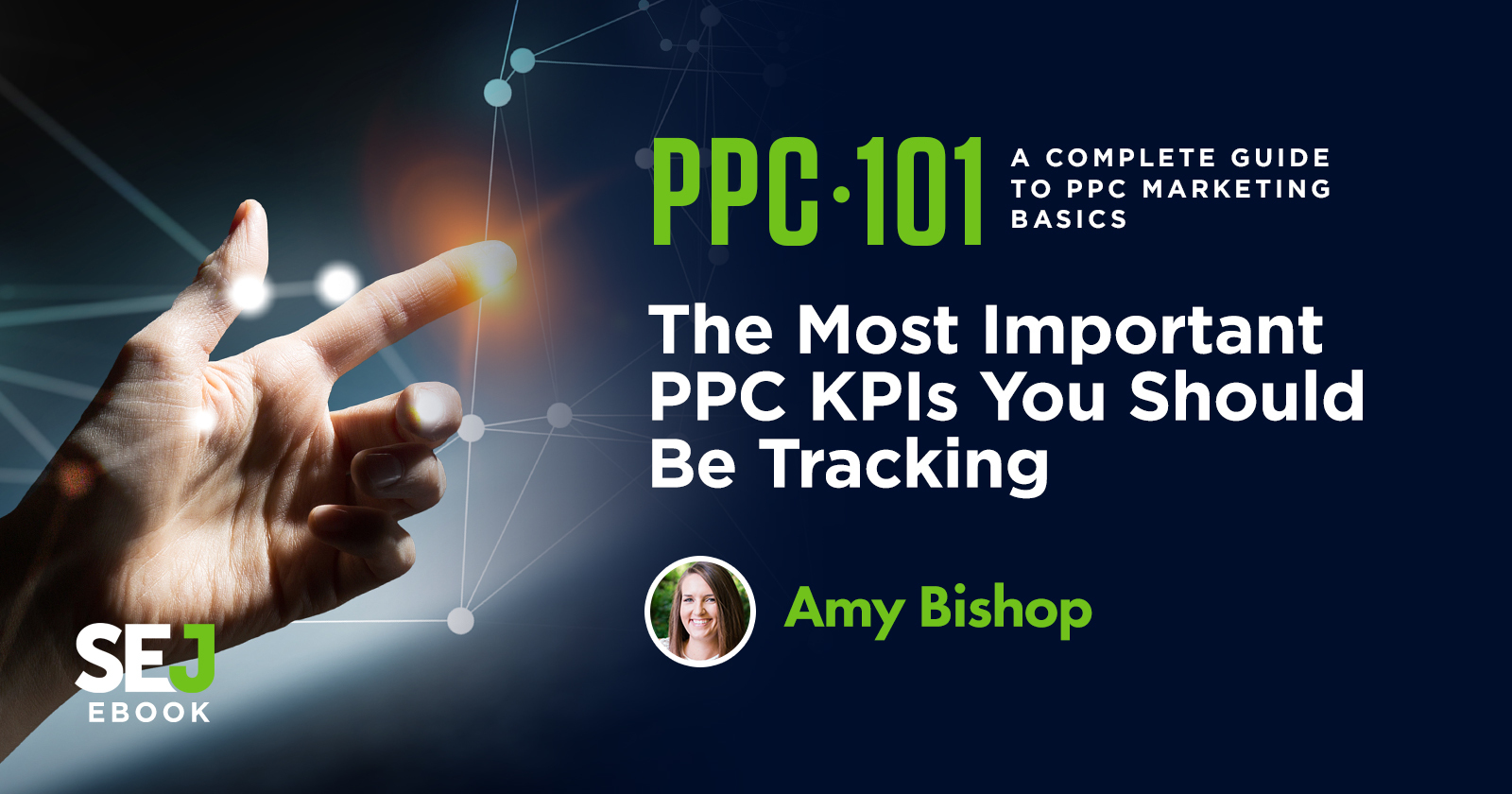The great thing about PPC is that we have so much data at our fingertips and we can make changes in real-time.
Sometimes, though, it can seem like paralysis by analysis if you don’t stay focused on the right metrics — or worse, if you focus too much on the wrong metrics.
There are so many great things to track and they each have their purpose.
But when it comes down to it, each campaign should have priority KPIs and these should be the focus, above and beyond anything else.
Let’s see what that looks like.
Defining Your Goals
Ultimately, the most important metric to track is the one that ladders up to your business goals. Before developing a PPC campaign, it’s important to determine what success looks like.
Think about the bigger picture, what is this campaign designed to do?
If you were in the board room today, explaining the value of this campaign, how would you describe this campaign’s impact on the organization?
The KPIs listed below support some of the most common marketing goals but yours may be something different entirely!
The point is that the most important metric that you track should be the one that aligns with your campaign’s end goal.
1. Measuring Sales Lift
Most PPC campaigns tend to ladder up to the goal of driving more sales, whether those sales come through ecommerce purchases, in-store sales, or leads that will eventually result in sales.
The starting points may be different but the goal is often the same.
If your PPC campaign is designed to increase sales then the most important KPIs that you can track are the ones that will ultimately help you to track whether PPC is impacting sales.
This is sometimes easier said than done, especially if the sale occurs offline.
Measuring Sales Lift for Ecommerce
Measuring sales lift is, dare I say, easiest for ecommerce companies as they have the benefit of tracking purchase data when it occurs.
For these companies, having tracking in place to measure sales (along with the additional purchase data) is a fundamental KPI.
Measuring Sales Lift for In-Store Purchases
Measuring in-store purchases can be a bit trickier but there are ways that advertisers can make some inferences around in-store sales.
One way to do this is by using first-party data to connect in-store transactions back to digital advertising campaigns.
Another way to do this is by offering folks to order in advance, or by offering coupons to use when they come into the store.
In the absence of the ability to match back transaction data, qualified advertisers can measure store visits metric to estimate the foot traffic driven through their campaigns.
Tracking the number of folks who use the location extension to get directions could be another way to measure the value of campaigns.
Measuring Sales Lift for Lead Generation
Measuring sales lift for lead gen campaigns is all about tracking the full customer journey. For most lead gen companies, lead volume and cost per lead are important KPIs to track but that’s only the tip of the iceberg as not all leads are created equal.
That’s why it’s also important to track Marketing Qualified Leads, Sales Qualified Leads, and the pipeline all the way through to sales.
Measuring the funnel conversion rates of leads helps advertisers to understand which channels, campaigns, and targeting options are driving the most valuable leads that are most likely to result in sales.
Measuring Sales Lift through Marketing Mix Modeling
If you don’t have a clear line of visibility from clicks to sales, and there’s no way for you to track all the way from the first interaction to the close, marketing mix modeling may be for you.
With marketing mix modeling, advertisers aim to monitor trends by looking at performance baseline and then monitoring performance against the baseline after certain marketing efforts have begun.
2. Revenue
The goal of increasing sales is almost always with the longer-term, bigger-picture goal of increasing revenue.
For ecommerce companies, this is straightforward and can be tracked alongside sales when purchase tracking is implemented. Advertisers that track their data all the way through the offline sales processes can collect this data, as well.
However, advertisers that have gaps between their online presence and their offline sales process may have to extrapolate this data using estimated sales data and average order values.
Even if the number is extrapolated, it’s ideal to have a rough idea of how campaigns are impacting the bottom line, if that’s the goal of the campaign.
3. Return on Ad Spend (ROAS)
To take this one step further, it’s helpful to keep a pulse on revenue as a ratio to ad spend.
ROAS is calculated by dividing revenue by ad spend.
This is a metric that can be used as a gauge to monitor whether your ad spend is driving the expected value – especially as your campaigns scale.
4. Profit & Return on Investment (ROI)
ROAS doesn’t take into account any other costs beyond ad spend, so it’s important to also keep an eye on profit and return on investment (ROI).
This ensures that the campaigns are still driving value even after all other costs are accounted for.
To take this one step further, it’s ideal that advertisers understand the lifetime value of their customers so that their calculations take future value into account.
5. Higher Funnel Engagement & Audience Performance
For some campaigns, the goal may be less focused on sales and more focused on higher funnel awareness and engagement.
In those cases, one could argue that measuring sales data is still important but it may be more difficult to attribute in some cases.
In those cases, there are other engagement metrics that are worth monitoring.
Brand Lift Data
Social advertising channels allow advertisers to run brand lift studies in order to monitor their campaign’s impact on brand lift as compared to a control group of folks who did not see their ads. Facebook even has an estimated brand recall metric that can be utilized outside of brand lift studies.
Brand lift studies can be costly, so they aren’t for everyone but there are other ways to monitor brand awareness.
Monitoring Branded Search
One easy way to monitor the impact of brand awareness campaigns is through branded search volume trends. If the awareness campaigns are working, branded search volume should be increasing.
View-Through & Assisted Conversions
Top of Funnel campaigns may not be big conversion drivers – if they are, great! That’s a good metric to track.
But if they aren’t, it can be helpful to keep an eye on their longer-term impact via view-through conversions and assisted conversions, assuming that the buyer journey isn’t too long for cookies to track.
Micro-Conversion Completions
A great way to get more concrete data is to drive higher funnel traffic to micro-conversions. You can define the micro-conversion based upon the goal of the campaign – for instance; measure the way folks engage with resources on your site.
How many video views did your landing page receive? How many people downloaded a product sales sheet?
How many folks subscribed to the newsletter?
These are all higher funnel actions that indicate that folks were interested enough in your company to make an effort to learn more.
Plus, now you can build an audience to target additional content toward them.
Audience Engagement
Once you’ve built an audience off of higher funnel engagement, keep an eye on that audience within Google Analytics’ audience report.
Monitor whether they return to the site and complete additional micro-conversions, and more importantly whether they tend to exhibit purchaser behaviors long term.
6. Campaign Health Metrics
Last but certainly not least, it’s important to track campaign health metrics.
I struggle to call these KPIs because they aren’t usually the metrics that tie closely to marketing goals.
However, they are the metrics that support the metrics that ladder up, so they are important. That’s why I deem these the campaign health metrics.
These can be indicative of whether the campaigns have more room to improve but they aren’t the metrics you’d bring up in a board room.
There are a million different metrics available to us in the ad platforms but these are some of the most foundational.
Cost Efficiency Metrics (CPCs, CPVs, CPMs)
The cost-efficiency of your initial interaction is a good metric to keep an eye on, whether that be CPCs, CPMs, CPVs, or something else.
This isn’t a KPI, of course, because it’s not something you’d optimize toward with blinders on.
For example, I’d happily pay a premium for clicks if it meant a higher conversion rate and a lower cost per sale.
Still, though, it’s worth keeping an eye on trends and identifying ways to improve the performance of your top campaigns.
Click-Through Rate
Click-through rate is a valuable metric because it gives you a sense of how relevant your ads are to the folks who are seeing them.
A low click-through rate may mean that ads could be improved, or it may mean that you aren’t targeting the right audience for your goals.
Monitoring trending performance is even arguably more important, as it allows you to ensure that you’re making continuous improvements – and quickly identify drops when they occur.
Conversion Rate
Conversion rate is indicative of whether your landing pages are relevant and well optimized for conversion.
If the conversion rate is low, it could be that something on the site isn’t resonating, or it could be that the audience that you’re targeting isn’t right for your business or possibly just isn’t in the right stage of the funnel to take action.
Similarly, click-through-rate monitoring conversion rate trends allows you to quickly spot changes for better or for worse.
Impression Share
Impression share is helpful to use as a gauge for how much more scale that you could get out of your existing campaigns, if you bid more aggressively or if you could come up with more budget.
On-Site Engagement
On-site engagement is a good early indicator for whether your audience is interested in what you’re selling.
Keeping an eye on things like bounce rate, average session duration, and the average number of pages visited allows you to understand whether your content seems to be resonating with prospects.
If on-site performance looks shoddy, it’s undoubtedly going to trickle down.
Quality Score
Quality Score is one of the fundamental components of the auction but it’s still a health metric, not a KPI.
It’s helpful to use quality score to identify where your campaigns have room to improve but I always recommend that you don’t let quality score distract from the primary goal.
For example, sometimes using dynamic insertion improves CTR, which can improve quality score, but it might have a lower conversion to impression ratio than your other ads.
In other words, while it might improve quality score it could negatively impact conversion volume and cost-efficiency.
All that to say, work toward improving quality score but always in support of your KPIs.
Featured Image Credit: Paulo Bobita





![AI Overviews: We Reverse-Engineered Them So You Don't Have To [+ What You Need To Do Next]](https://www.searchenginejournal.com/wp-content/uploads/2025/04/sidebar1x-455.png)